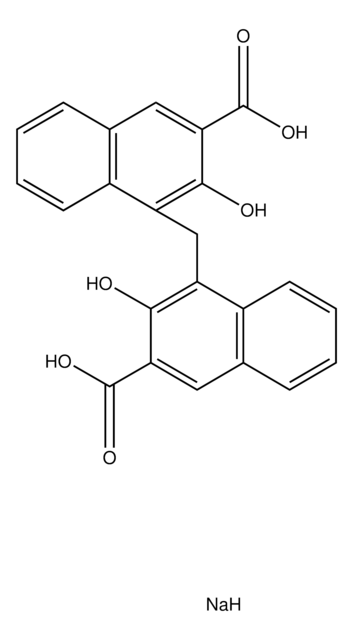M9292
Memantine hydrochloride
≥98% (GC), powder, NMDA glutamate receptor antagonist
Sinônimo(s):
3,5-Dimethyl-1-adamantanamine hydrochloride, 3,5-Dimethylamantadine hydrochloride, 3,5-Dimethyltricyclo[3.3.1.13,7]decan-1-amine hydrochloride
About This Item
Produtos recomendados
product name
Memantine hydrochloride, ≥98% (GC)
Ensaio
≥98% (GC)
forma
powder
originador
Forest Labs
cadeia de caracteres SMILES
Cl.C[C@]12CC3C[C@](C)(C1)CC(N)(C3)C2
InChI
1S/C12H21N.ClH/c1-10-3-9-4-11(2,6-10)8-12(13,5-9)7-10;/h9H,3-8,13H2,1-2H3;1H/t9-,10+,11-,12-;
chave InChI
LDDHMLJTFXJGPI-VXMZOEJHSA-N
Informações sobre genes
human ... DRD1(1812) , DRD2(1813) , DRD3(1814) , DRD4(1815) , DRD5(1816)
Procurando produtos similares? Visita Guia de comparação de produtos
Aplicação
- as a media supplement to serve as a control to study the neuroprotective effects of erythropoietin in N-methyl-D-aspartate receptor-induced toxicity
- to intraperitoneally inject experimental animal to study its effect on traumatic injury
- as a test compound to determine the dynamic range and selectivity of retinal pigment epithelium tissue penetration
Ações bioquímicas/fisiológicas
Características e benefícios
Código de classe de armazenamento
11 - Combustible Solids
Classe de risco de água (WGK)
WGK 3
Ponto de fulgor (°F)
Not applicable
Ponto de fulgor (°C)
Not applicable
Equipamento de proteção individual
Eyeshields, Gloves, type N95 (US)
Certificados de análise (COA)
Busque Certificados de análise (COA) digitando o Número do Lote do produto. Os números de lote e remessa podem ser encontrados no rótulo de um produto após a palavra “Lot” ou “Batch”.
Já possui este produto?
Encontre a documentação dos produtos que você adquiriu recentemente na biblioteca de documentos.
Artigos
Discover Bioactive Small Molecules for ADME/Tox
DISCOVER Bioactive Small Molecules for Neuroscience
Nossa equipe de cientistas tem experiência em todas as áreas de pesquisa, incluindo Life Sciences, ciência de materiais, síntese química, cromatografia, química analítica e muitas outras.
Entre em contato com a assistência técnica







